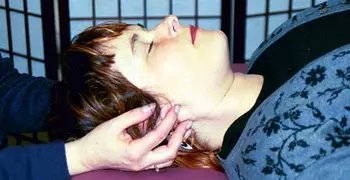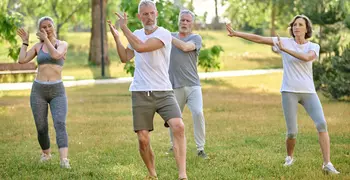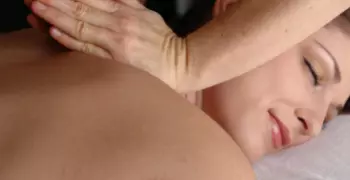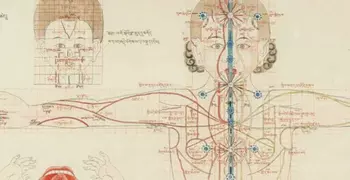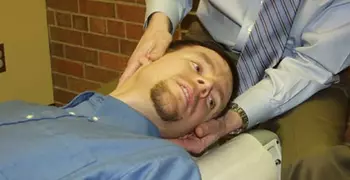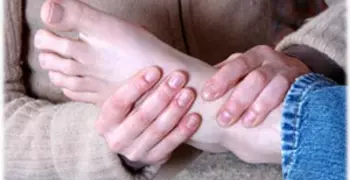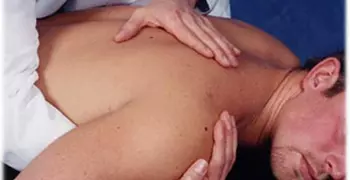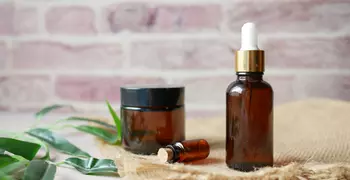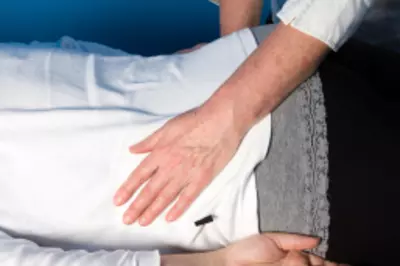
 In Therapeutic Touch, therapists place their hands on or near their patient's body with the intention to help or heal. In doing so, therapists believe that they are consciously directing or modulating an individual's energies by interacting with his or her energy field. The focus is on balancing the energies of the total person and stimulating the body's own natural healing ability rather than on the treatment of specific physical diseases.
In Therapeutic Touch, therapists place their hands on or near their patient's body with the intention to help or heal. In doing so, therapists believe that they are consciously directing or modulating an individual's energies by interacting with his or her energy field. The focus is on balancing the energies of the total person and stimulating the body's own natural healing ability rather than on the treatment of specific physical diseases.
Therapeutic Touch is based on the following assumptions:
- The human being is an open energy system composed of layers of energy that are in constant interaction with self, others, and the environment.
- Illness is an imbalance in an individual's energy field.
- Clearing or balancing the energy field promotes health.
- All humans have natural abilities to heal and enhance the healing in others.
More about Therapeutic Touch
Standarized in 1970s
Therapeutic Touch is a contemporary interpretation of several ancient laying-on-of-hands healing practices. Delores Krieger, PhD, RN, professor emeritus of Nursing at New York University, and Dora Kunz, a gifted energy healer, developed and standardized the technique in the 1970s. This standardization facilitates research and evaluation of treatment effects.
Considered a biofield energy therapy
Therapeutic Touch is categorized as a biofield energy therapy by the National Center for Complementary and Integrative Health (NCCIH). Biofield therapies are techniques that intend to affect energy fields that surround and penetrate the human body. NCCIH notes that, although scientists are studying these phenomena, the existence of such fields has not yet been definitively proven.
Complements conventional care
Therapeutic Touch is not a substitute for medical treatment. It does complement conventional medical care and supports the person's body to be in the best condition to heal. Therapeutic Touch is beneficial with other therapies, such as acupressure, massage, imagery, biofeedback, and psychotherapy.
What is the difference between Therapeutic Touch and Healing Touch?
Therapeutic Touch is a specific energy technique developed by Delores Krieger. Healing Touch is a collection of techniques developed and compiled by Janet Mentgen in the early 1980s.
What is a session like? 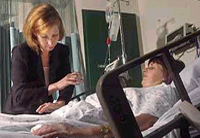
A typical session lasts approximately 15 to 30 minutes. You will sit in a comfortable chair and lie down fully clothed. The Therapeutic Touch practitioner will begin by discussing your goals for healing. He or she will then use light touch and/or sweeping hand motions above the skin surface to assess and balance the energy in and around the body.
Therapeutic Touch practitioners generally follow these steps.
- Center themselves in the present moment and bring themselves to a calm, quiet state of consciousness.
- Assess the client's energy field.
- Clear and mobilize the client's energy field, direct energy to achieve wholeness, and balance the field.
- Evaluate and close the treatment.
- Ask for feedback and answer client questions.
How might Therapeutic Touch benefit your health and wellbeing?
 The goal of Therapeutic Touch is to assist the recipient in tapping into their own healing process and to restore wholeness and wellbeing at the physical, emotional, mental, and spiritual levels of the person.
The goal of Therapeutic Touch is to assist the recipient in tapping into their own healing process and to restore wholeness and wellbeing at the physical, emotional, mental, and spiritual levels of the person.
Therapeutic Touch does not attempt to cure disease, but rather to stimulate the body's natural healing process. According to Therapeutic Touch texts, the major effects of Therapeutic Touch are a deep relaxation response, reduction of pain and anxiety, and faster wound healing.
Practitioners believe that this therapy promotes health and wellbeing and eases the dying process. Patients who are undergoing chemotherapy or radiation have found it helpful in reducing side effects of treatment, such as nausea, vomiting, weakness, or fatigue. Others have seen reduced feelings of anxiety or grief.
Therapeutic Touch can benefit people of all ages and all states of health or illness, as well as plants and animals.
This therapy is generally very safe, but precautions need to be taken with pregnant women (since there is more than one energy field), and people with some forms of mental illness. Experienced practitioners will take these factors into account.
What does the research show?
The popularity of Therapeutic Touch in the nursing profession has encouraged research in this area. There have been more studies on Therapeutic Touch than other biofield energy therapies (Reiki, Healing Touch). There is a large enough body of evidence to conduct formalized analysis.
Early Therapeutic Touch studies reported by Heidt indicate efficacy in muscle relaxation and stress and anxiety reduction. Later studies identify physiological effects (pulse amplitude, blood pressure, pulse, and temperature) as well as subjective measures, such as stress, time perception, and self-assessment of health.
Where can I find a practitioner?
The best way to choose a practitioner is to get a referral from a trusted source. Before you visit, ask the practitioner about his or her educational preparation and experience. Make sure the practitioner has completed three levels of training and a supervised mentorship. Explain your specific needs and ask if he/she has worked with similar cases and if he/she can confidently serve you.
You should feel comfortable working with the Therapeutic Touch practitioner.
Organizations and websites
Nurse Healers-Professional Associates International (Official organization of Therapeutic Touch)
Therapeutic Touch at Pumpkin Hollow Farm (Official website of Delores Krieger; includes information about classes)
Books
Kreiger, D. (1993). Accepting Your Power to Heal: The Personal Practice of Therapeutic Touch. Santa Fe, NM: Bear & Company, Inc.
Krieger, D. (1997). Therapeutic Touch Inner Workbook. Santa Fe, NM: Bear & Company, Inc.
Kunz, D. (1995). Spiritual Healing: Doctors Examine Therapeutic Touch and Other Holistic Treatments. Wheaton, IL: Quest Books.
Macrae, J. (1988). Therapeutic Touch: A Practical Guide. New York: Alfred A. Knopf.
Wagner, S. (1996). A Doctor's Guide to Therapeutic Touch. New York: Perigree Trade.
References
Engebretson, J., Wardell, D. (2007). Energy based modalities. Nursing Clinics of North America, 42, 243-259.
Gagne, D., Toye, R. (1994). The effects of therapeutic touch and relaxation therapy in reducing anxiety. Archives of Psychiatric Nursing, 8, 184-189.
Heidt, P. (1981). The effects of therapeutic touch on anxiety level of hospitalized patients. Nursing Research, 30, 32-37.
Kreiger, D. (1993). Accepting Your Power to Heal: The Personal Practice of Therapeutic Touch. Santa Fe, New Mexico: Bear & Company, Inc.
Peck, S. (1997). The effectiveness of therapeutic touch for decreasing pain in elders with degenerative arthritis. Journal of Holistic Nursing, 15(2), 176-198.
Peters, R. (1999). The effectiveness of therapeutic touch: a meta-analytic review. Nursing Science Quarterly, 12(1), 52-61.
Quinn, J. (1989). Therapeutic touch as energy exchange: replication and extension. Nursing Science Quarterly, 2(2), 79-87.
